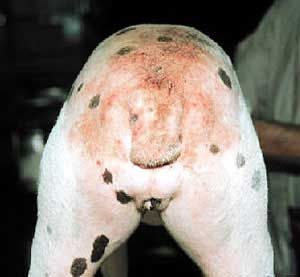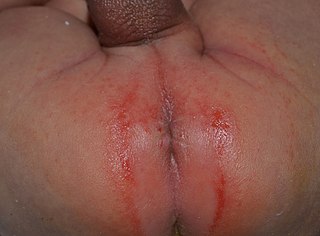
Irritant diaper dermatitis is a generic term applied to skin rashes in the diaper area that are caused by various skin disorders and/or irritants.

Miliaria, also called "sweat rash", is a skin disease marked by small and itchy rashes due to sweat trapped under the skin by clogged sweat gland ducts. Miliaria is a common ailment in hot and humid conditions, such as in the tropics and during the summer season. Although it affects people of all ages, it is especially common in children and infants due to their underdeveloped sweat glands.

A papule is a circumscribed, solid elevation of skin with no visible fluid, varying in area from a pinhead to 1 cm. It can be brown, purple, pink or red in color, and can cluster into a papular rash. Papules may open when scratched and become infected and crusty. Larger non-blisterform elevated lesions may be termed nodules.

Erythroderma is an inflammatory skin disease with redness and scaling that affects nearly the entire cutaneous surface. This term applies when 90% or more of the skin is affected.
Perioral dermatitis is a type of skin rash. Symptoms include multiple small (1–2 mm) bumps and blisters sometimes with background redness and scale, localized to the skin around the mouth and nostrils. Less commonly the eyes and genitalia may be involved. It can be persistent or recurring and resembles particularly rosacea and to some extent acne and allergic dermatitis. The term dermatitis is a misnomer because this is not an eczematous process.
Erythema toxicum neonatorum is a common rash in neonates. It appears in up to half of newborns carried to term, usually between day 2–5 after birth; it does not occur outside the neonatal period.
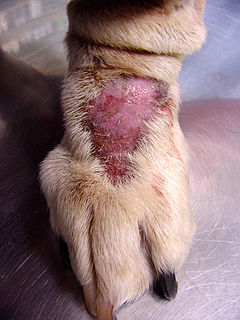
A lick granuloma, also known as acral lick dermatitis, is a skin disorder found most commonly in dogs, but also in cats. In dogs, it results typically from the dog's urge to lick the lower portion of one of their legs.

Eosinophilic granuloma is a form of Langerhans cell histiocytosis. It is a condition of both human and veterinary pathology.

Feline acne is a problem seen in cats primarily involving the formation of blackheads accompanied by inflammation on the cat's chin and surrounding areas that can cause lesions, alopecia, and crusty sores. In many cases symptoms are mild and the disease does not require treatment. Mild cases will look like the cat has dirt on its chin, but the dirt will not brush off. More severe cases, however, may respond slowly to treatment and seriously detract from the health and appearance of the cat. Feline acne can affect cats of any age, sex or breed, although Persian cats are also likely to develop acne on the face and in the skin folds. This problem can happen once, be reoccurring, or even persistent throughout the cat's life.
Chronic actinic dermatitis is a condition where a subject's skin becomes inflamed due to a reaction to sunlight or artificial light. Patients often suffer from other related conditions of the skin that cause dermatitis in response to a variety of stimuli.

Superficial lymphatic malformation is a congenital malformation of the superficial lymphatics, presenting as groups of deep-seated, vesicle-like papules resembling frog spawn, at birth or shortly thereafter. Lymphangioma circumscriptum is the most common congenital lymphatic malformation. It is a benign condition and treatment is not required if the person who has it does not have symptoms from it.
Id reactions are types of acute dermatitis developing after days or weeks at skin locations distant from the initial inflammatory or infectious site. They can be localised or generalised. This is also known as an 'autoeczematous response' and there must be an identifiable initial inflammatory or infectious skin problem which leads to the generalised eczema. Often intensely itchy, the red papules and pustules can also be associated with blisters and scales and are always remote from the primary lesion. It is most commonly a blistering rash with itchy vesicles on the sides of fingers and feet as a reaction to fungal infection on the feet, athlete's foot. Stasis dermatitis, allergic contact dermatitis, acute irritant contact eczema and infective dermatitis have been documented as possible triggers, but the exact cause and mechanism is not fully understood. Several other types of id reactions exist including erythema nodosum, erythema multiforme, Sweet's syndrome and urticaria.
Autoimmune progesterone dermatitis may appear as urticarial papules, deep gyrate lesions, papulovesicular lesions, an eczematous eruption, or as targetoid lesions. Autoimmune progesterone dermatitis initially manifests with eye symptoms, e.g. burning, and progresses into rashes. Its relapsing-remitting pattern in women correspond to the progesterone levels during the menstrual cycle, which spike twice a month. It is an extremely rare disease.
Perforating granuloma annulare is a skin condition of unknown cause, usually appearing on the dorsal hands, presenting as papules with a central keratotic core.
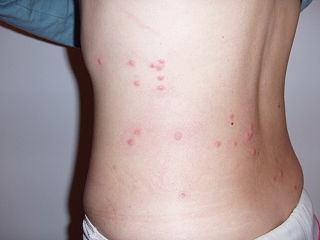
Pulicosis is a skin condition caused by several species of fleas, including the cat flea and dog flea. This condition can range from mild irritation to severe irritation. In some cases, 48 to 72 hours after being bitten, a more severe rash-like irritation may begin to spread across the body. Symptoms include swelling of the bitten area, erythema, ulcers of the mouth and throat, restlessness, and soreness of the areolae. In extreme cases, within 1 week after being bitten, the condition may spread through the lymph nodes and begin affecting the central nervous system. Permanent nerve damage can occur.
Eruptive pseudoangiomatosis is a cutaneous condition characterized by the sudden appearance of 2- to 4-mm blanchable red papules.
Alphavirus infection may be caused by a Sindbis virus infection, and result in a cutaneous eruption of multiple, erythematous, 4- to 4-mm papules.
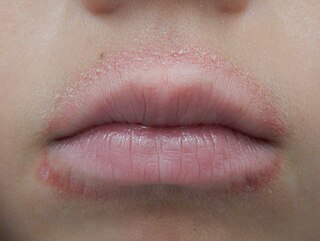
Lip licker's dermatitis, popularly known as perioral dermatitis, is an Irritant contact dermatitis on and around the lips due to saliva from repetitive lip licking. Involving children more than adults, the resulting papules, scaling, erythema and occasional fissures and crusting make a well-defined ring around the lips. The rash extends as far as the tongue can reach and frequently spares the angle of the mouth. Unlike periorificial dermatitis, the vermillion border of the lip is often involved and the treatment is simple moisturisers.

Cats exposed to allergens may develop allergies or allergic reactions. Allergies tend to become evident and intensify over extended periods of time and can take years to develop. Some allergic diseases and allergies in cats include feline atopic dermatitis, flea allergy dermatitis, feline-mosquito hypersensitivity, and food-induced allergy. In the case of feline atopy, hypersensitivity to allergens is due to genetic predisposition. However, various allergies may arise due to environmental factors. Allergens, ingested, inhaled, or airborne, can be seasonal or non-seasonal, similar to allergies in humans. Suspected seasonal allergens include but are not limited to pollen, fleas, and mosquito bites; suspected non-seasonal allergens include but are not limited to plastic materials, food, dust, trees, and grass. After exposure to suspected allergens, symptoms may be immediate or delayed, arising within a few minutes to two hours. Symptoms can include both dermatological and gastrointestinal signs such as itchy skin, hair loss and excessive scratching. In cases of feline atopic dermatitis or atopy in cats, pruritic skin diseases may result; however, signs can also include miliary dermatitis, symmetrical alopecia, and lesions of the eosinophilic granuloma complex.



